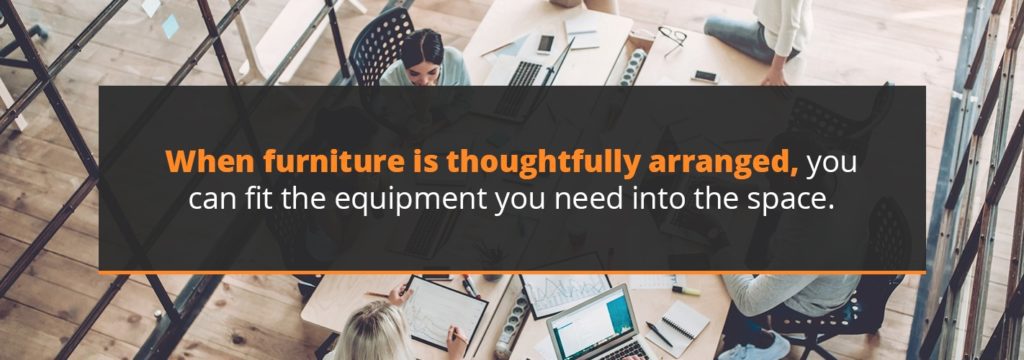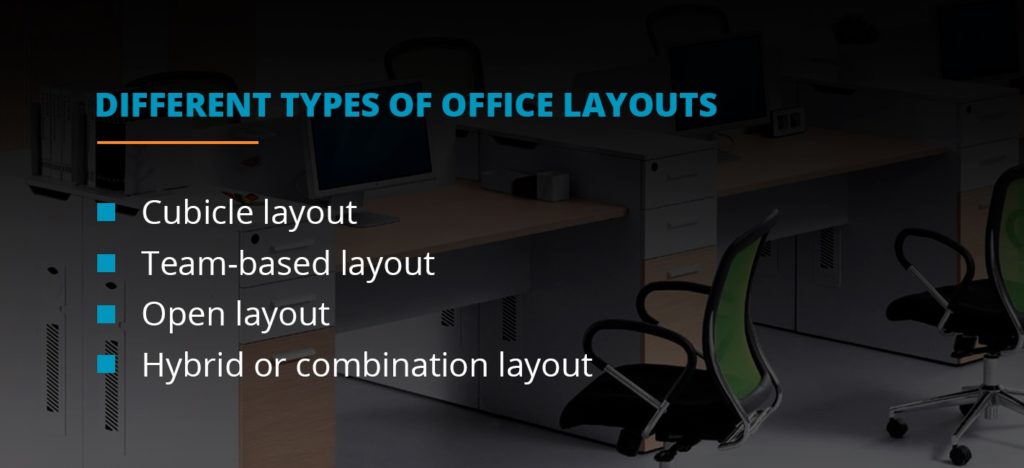Table of Contents
- Office Design Guide
- Chapter 2: What Are the Common Types of Office layouts?
- Chapter 3: How to Choose an Effective Office Layout for Your Company
- Chapter 4: Office Design Ideas and Considerations
- Chapter 5: How to Choose the Right Office Furniture
- Chapter 6: How to Install and Assemble Office Furniture

The office layout refers to how the equipment, furniture and supplies are arranged within the space. Office layout impacts efficiency and comfort levels for employees. For example, imagine placing call center employees at a large central table — with no dividers between the workers. The disregard for privacy and acoustics would probably make it hard for each employee to concentrate and do their jobs well. On the other hand, if the same employees had quiet, private workspaces, they could hear customers through their headsets with a lot less effort. It’s also important to arrange furniture thoughtfully so you can fit the equipment you need into the space. When you make the most of the space you have, you can save on remodeling costs and keep employees from taking too many extra steps. In this chapter, we’ll explore common office layouts to help you find the right fit for your business. If you need assistance deciding on a layout, reach out to us at Sunline Office – that’s what we’re here for.
How Do You Plan An Office Layout?
To plan your office layout, you need to consider several factors first, such as:
- Privacy: Consider the level of privacy your employees need to complete their job duties. This is important for employees requiring high levels of concentration. For instance, you probably don’t want to place quiet areas alongside heavily trafficked walkways. You’ll want to prioritize privacy if it will positively impact productivity.
- Noise: Consider noise levels and how they can affect productivity and the ability to focus. This might involve placing copy machines and other equipment in separate rooms away from individual workstations. Likewise, you may not want to put the research department right next to the ping-pong room.
- Meeting spaces: Think about where and how often you wish to have meetings and how much space you need. For example, if you frequently need to meet with employees but still want to give them personal workspaces, you might have a central collaboration area and individual cubicles lining the perimeter.
- Natural light: Consider ways to maximize the use of natural light in your layout. Natural light is a free mood-boosting resource you don’t want to waste if it’s available, but be sure to consider glare when arranging workspaces in a sunlit room. Plan to balance artificial light with natural light to ensure workstations are always adequately lit.
- Departments: Think about your company’s different departments and which ones should be located close to each other to improve workflow. For example, you may want to place the research and development department next to the marketing department, so workers can frequently collaborate without having to walk too far.
- Accessibility: Your office should include accessible routes and workstations to accommodate individuals with disabilities. For example, office furniture should be placed a minimum of 32 inches from walls to allow easy access in a wheelchair. Be sure to consider accessibility when you design your new layout and how it might impact current or future employees.
Once you’ve considered what you need in your space and its purpose, start mapping out furniture placement to help you envision the layout you want. You might start with a copy of the current office floor plan or use a layout tool online. As you map out a detailed floor plan, consider lighting, pathways and the different employee departments. Make sure to include elements you plan to keep, such as the conference room or kitchen, and mark anything you wish to remove. Add existing furniture into the plan, and place electronic equipment near power outlets if possible. Experiment with new furniture ideas and layouts once you have the static pieces in place. If you need inspiration, you might browse office floor plans online to view examples or skip to the next chapter of this guide for layout ideas. We’ll look at the different types of layouts next to help you along.
What Are The Different Types Of Office Layouts?

If you asked someone to describe what the average office looks like, they’d probably mention rows of cubicles. While cubicles are still essential components in a lot of offices, they are only part of the solution. Here are the different common types of layouts, cubicles included:
- Cubicle layout: Also called a closed layout, this is a traditional style that utilizes partitions to create private, partially enclosed workspaces for employees. Cubicles help employees stay focused, and in some cases, are necessary parts of an effective layout. For employees who need privacy and minimal distractions, a cubicle layout is probably your best option. With cubicles, employees can also personalize their workspaces, have convenient access to the belongings in overhead storage cabinets, and still be close enough to co-workers to collaborate.
- Team-based layout: With a team-based layout, you’d form separate work areas to accommodate different teams. Usually, this type of layout includes individual workstations and a space for collaboration within each department. A team-based layout helps employees with similar roles work together on a single project. It may also include different compartmentalized areas designed for specific tasks.
- Open layout: An open layout generally means the space is free of partitions and private workspaces, and individual desks may be replaced with large tables or benching systems. With an open plan, employees might move around throughout the day and work at different stations. Open plans may be ideal for highly collaborative or social work environments. Even with open layouts, it’s a good idea to include quiet spaces where employees can hold private calls or complete tasks that require a high level of concentration.
- Hybrid or combination layout: A hybrid layout combines an open plan with individual workstations. Hybrid layouts are flexible and allow you to create a tailored environment. Choosing furniture that can easily be reconfigured can help you create a hybrid layout. You might also include low partition walls to encourage interaction while still providing some level of privacy. Hybrid layouts may be the ideal solution for accommodating both the introverts and extroverts in the workplace.

Need help with a custom layout design? Give us your floor plan and requirements, and our team of experts will design a layout that meets your needs.
